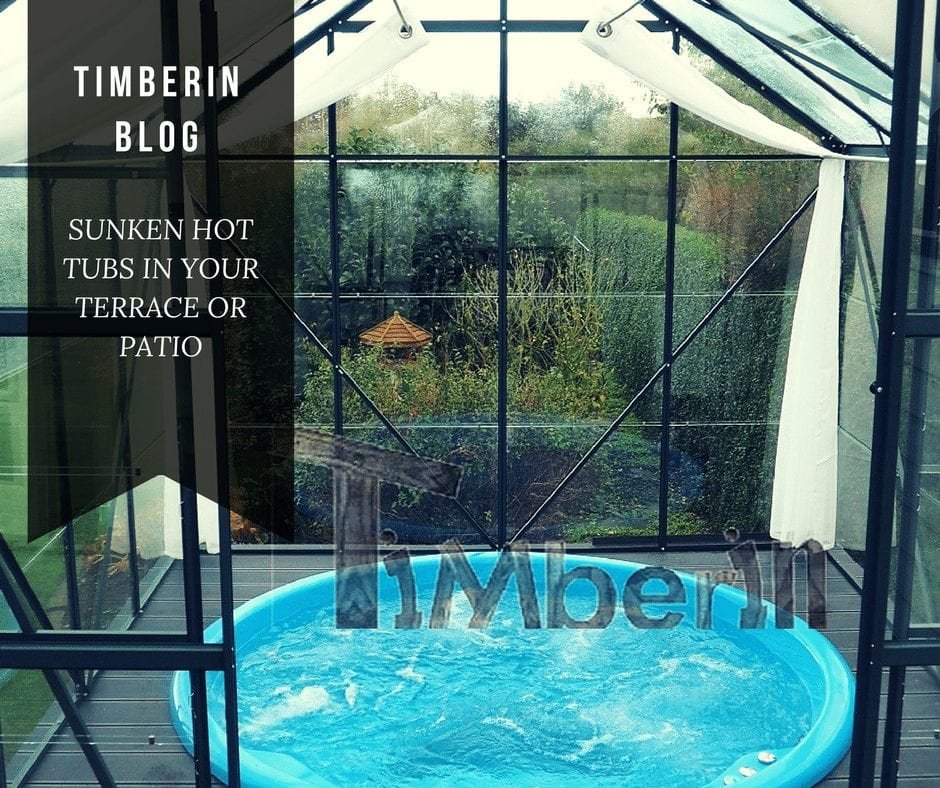A sunken hot tub (also called in-ground or built-in) delivers a sleek, resort-style look with easier step-in access. It also demands careful planning—excavation, waterproofing, drainage, insulation, and service access. Use this guide to design and install a sunken spa that looks stunning and performs for years. For layout ideas and siting, see our sunken hot tub guide.
New to hot tubs? Start with how a wood-fired hot tub works.
1) Why Choose a Sunken Hot Tub? Pros & Trade-Offs
Pros
- Seamless look: Flush with paving or decking for a minimal, high-end aesthetic.
- Easy access: Lower rim height simplifies entry/exit.
- Wind shielding: Surrounding deck helps reduce heat loss and splash.
- Space-smart: Works well on sloped sites using vertical space.
Trade-Offs
- More complex excavation, waterproofing, insulation and drainage.
- Requires planned service access for pump/heater/valves.
- Higher consequences for mistakes (leaks, hydrostatic pressure, heat loss).
2) Site Survey & Foundation Planning
- Soil & groundwater: Assess soil type and water table; include perimeter drains and free-draining backfill to relieve pressure.
- Base/slab: Use a reinforced concrete slab (raft) sized for water + tub + bathers. Laser-level to avoid stress points.
- Pit clearance: Leave space for insulation, membranes, plumbing runs, and access panels.
Choosing exterior materials? Compare best wood for outdoor hot tubs & saunas.
3) Shell, Waterproofing & Insulation
- Shell options: Acrylic/fibreglass shells set in a pit; or a wooden barrel adapted for partial in-ground installs.
- Waterproofing: Tank the pit (cementitious or membrane), seal penetrations with flexible gaskets/sealants, and protect edges with copings.
- Insulation strategy: Add rigid boards under the tub and along pit walls; consider a thermal break below the slab in cold regions.
Want greener running costs? See eco-friendly hot tub tips.
4) Plumbing, Filtration & Overflow
- Plan pipe routes before backfill; use flexible couplers to handle minor movement.
- Include skimmer/overflow control and an accessible drain for the pit/tub.
- Set pump, heater and filter in a service chamber with ventilation and safe clearances.
Keep the water pristine with our guide to water care options.
5) Deck, Copings & Safety
- Finish the rim with flush copings and hidden trim for a seamless look.
- Use slip-resistant surfaces and add handholds where helpful.
- Integrate drainage channels around the surround to divert rain and splash away from the tub edge.
6) Commissioning: Fill, Test & Monitor
- Pressure-test lines and inspect seals before filling.
- Fill slowly; purge air, run circulation, check for leaks and balance chemistry.
- Monitor the first week for settlement, movement, or moisture ingress.
For seasonal protection and cost control, read winter hot tub care and general maintenance tips.
7) Common Pitfalls & Preventative Fixes
| Issue | Likely Cause | Prevention/Fix |
|---|---|---|
| Water behind shell | Weak waterproofing / no perimeter drain | Tank the pit; install perimeter drain & drainage backfill |
| Heat loss to ground | No base/wall insulation | Rigid insulation under tub and along pit walls; thermal break |
| Cracked slab or coping | Poor sub-base compaction / settlement | Compact sub-base; use reinforcement and expansion joints |
| Difficult servicing | No access to plant area | Plan removable panels/service chamber from day one |
Conclusion
A sunken hot tub can be a show-stopping feature—if you get the fundamentals right: foundation, waterproofing, insulation, drainage, and service access. Combine those with disciplined water care and seasonal maintenance, and your in-ground spa will look incredible and run efficiently for years.

